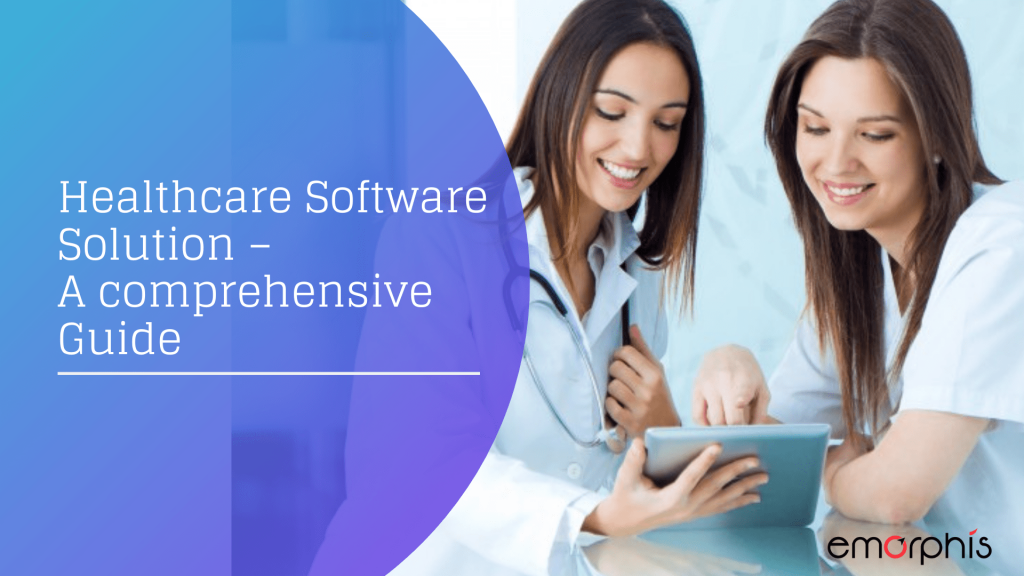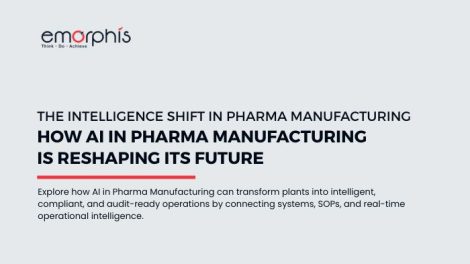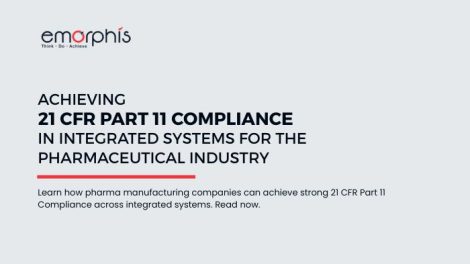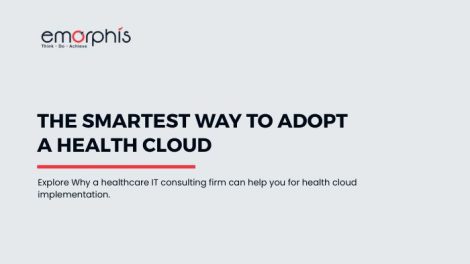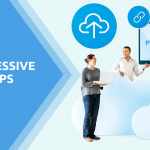Introduction
The inclination towards a healthy lifestyle and wellbeing combined with monitoring also, guidance with the help of tech gadgets has led to a surge in the demand for healthcare apps. With the increase in demand, there is a race on the supply side – healthcare app providers to provide high-quality software coupled with the state-of-the-art user experience targeting simplicity and minimalistic design.
Having said that, designing and developing a custom healthcare app is altogether a different ball game from the design and development process of traditional enterprise software. The right mix of the user, also apt technology, interoperability with healthcare systems and deep understanding of the regulatory requirements formulates the perfect recipe for a successful healthcare software application.
According to a study, 80% healthcare app failed miserably after launch an alarming number to keep in mind while conceptualizing the solution. In fact, don’t go by the rational of past success stories in other industry sectors and duplicating the effort and model in the healthcare sector as it is a tricky affair. With the perfect mix of the user, technology and regulatory requirements ensures a high-quality product, reduced cost in design and developments, a higher adoption and success rate with the end customer, and improved efficiencies in case of institutional or industrial non-customer-based healthcare software solution. Here we discuss in detail the know-how of user, technology and regulations from a design and development perspective.
User
Typical user for a healthcare application is patient and healthcare practitioners – Doctors, Nurse, also Medical Administration, and Clinician. It is very important to know these set of users in and out. In fact, as there are multiple users often, sorting and bucketing these users into a homogenous group is a smart move. Moreover, the entire idea and concept of the healthcare app should be focused around these users and their requirements from such health applications. In fact, such users should be considered as end customers and techniques such as customer journey mapping and customer personas should be applied to know your customer.
Customer journey maps are a visual representation of customer experience also, right from the starting point of customer contact with your business to a long-term relationship.
Whereas customer persona helps you define the key traits, habits and patterns of your target audience. It gives you an insight into what the customers are thinking and doing as they weigh for options that address the problem they want to solve.
From a design and moreover, development perspective as well, such problems should be addressed through the healthcare software solution.
For instance, medical administration have routine tasks. This manual repetitive tasks and human interventions generally lead to prone errors resulting in inefficient patient care. Healthcare app should aim for automating these manual routine processes, so that medical practitioners can focus on quality patient care as a result of time-saving measures along with the added advantage of cost reduction.
Research Methodologies & Dimensions
A blend of the right qualitative and quantitative techniques would help you interpret data better, thus helping in knowing your user or end customer better. Selection of research tools should aim at these aspects – customer requirements, challenges faced, and the overall experience. Preach vs. Practice methodology is also useful as it distinguishes between people’s attitude and behavior, the basic difference between what people say and what they practice. Interviewing people to gather understanding and silently observing the practice can help determine the deviation.
How to efficiently and effectively use research data
Use of historic data, analytics in existing systems and interviewing staff based on identified focus group can help identify patterns also, formulate storyboards for better understanding. Moreover, one good starting point is user manual, documentation and quick reference guide. These documents along with observations on daily activities provide a big picture and also, create a customer picture on the canvas.
Filled in questionnaires comprising of Likert scale and open-ended questions can help determine user preferences and also, customer behaviors, provides actionable facts and insights, and establish firm traits and attitudes.
Stakeholders – Each one has their own varied needs, wants and requirements
Each stakeholder i.e. people associated with healthcare have their own journey, experiences and requirements. For Instance, the expectation of a patient from a healthcare app – to be user friendly, interactive, also ensures data privacy and security of information. Whereas on the other hand, practitioners are more concerned from a regulatory perspective. Moreover, from a design perspective as well, the interface for practitioners and patients should be different and customized. Within patient category as well – ‘routine’ and ‘chronic’ can be a very good segregation criterion.
Designing behavior shifting adoption
Once you have identified the customer in totality, the next drive should be towards customer adoption. Interactive design, timely notifications, and gamification help drive adoption to a great extent. Emotional needs identified through research techniques such as customer journey mapping and personas should be incorporated in the design and development of applications. For designers and developers, one thing that should always ping in their brain is – ‘providing value to the customer’ through your healthcare app.
For Instance, a chronic patient scenario of type II diabetes, the patient would want to record data for regular monitoring and draw a correlation with their activities such as – physical work out, food, change in lifestyle etc.
The patient would also look for timely notifications to consumer pills, inject insulin shots or measure, monitor and store blood sugar and glucose levels. Facilities such as booking doctor appointments, integrations with technology gadgets such as smartwatches, smartphones and tablets. Access to real-time information anywhere and everywhere. The platform for people-to-people interaction such as forums, communities and discussion boards. These pointers sum up as added value to the patient.
Technology
The second step after identifying the customer, is the decision making on shortlisting and selecting the right technology. Important criteria to consider is the target audience (know your customer), functionality, competitive landscape, development team skill set, application support post release etc. Value to effort ratio should be high, else all efforts put forward from developers would go in vein.
Another important criterion to consider is whether your application would run on a single platform or multiple platforms. For instance, a software app designed and developed for Apple IOS users would obviously run on a single platform, here native technology is very helpful. Whereas considering another scenario where a healthcare app is ideated for both Android and IOS platforms, here HTML 5 is a better option and preferred over native technology as it must be coded only once and further can be deployed on different platforms.
Find the details of ehealth Technologies.
Choosing the right technology
Developers need to be cognizant of the fact that while choosing the right technology especially for Mobile and IoT, comfort and interest should not be the criteria. In fact, right technology for the right purpose should be the criteria. Tech stack should be the end goal for both target audience and developers. After thoroughly reviewing the app functionality the technology & platform should be zeroed down. Concepts such as Minimum Viable Product (MVP) should be taken under consideration.
Choosing frameworks
After ensuring the end user and context, next to follow is deciding the right hardware platform, software architecture and development framework. Platform under consideration should investigate the fact whether the application is for consumer or non-consumer industrial or institutional solution such as mobile EHR app where work flow and customization precedes over user experience.
The development processes
More often it seen that any delay or issue is not a resultant of technology and or scope, it is usually the process followed in the software development. Highly recommended is the agile methodology based on scrum integrating user experience research and design and multi-site software development following two three sprints.
Two other aspects to consider are – ‘Requirement repository’ and ‘Design & Build’ for the lead customer. The requirements should be housed in a central library with task tracking system. The strategy should be to create UX research, design and test based on lead customer’s requirements.
Using small and big Data
Small data, typically homogeneous in nature can be used to find specific insights. Whereas for dealing with volume, velocity and variability of data, big data comes into picture which is almost all the time heterogenous in nature. With help of tools, processes and data expert big data can be translated into small data for informed decision making. In certain scenarios there is an influx of both big and small data; big data coming with features of volume, velocity (speed of light), and variety and simultaneously small data entering the organization with much smaller pace.
Regulatory Requirement
Regulatory requirements often translate into business requirements as software app needs to comply with compliance & governance laid down by regulatory bodies. The reason for this is to ensure patient’s personal data security and privacy measures. Patient’s sensitive data is collected and stored such as – Name, e-mail ID, mobile number, social security number and health ID, in fact this amount of information is more crucial and sensitive than credit card information.
According to a report, patient data is traded for almost 50 USD as compared to 5 USD credit card details in the open black market. Thus, it has been a priority for healthcare IT infrastructure to comply with regulations such as HIPAA. With the advent of digital era and progress in the field of Internet of Medical Things (IoMT) it has become increasingly important to meet the regulatory requirements to a great extent. With IoT, especially hardware, sensors and wearables, if in case is hacked, starts malfunctioning can put patient’s health and life at risk.
Interoperability
The basic objective of the concept of Interoperability is enhancing individual health. Interoperability can be defined as the aptitude of diverse IT systems, sensor devices and apps to link, in a coordinated way, within and beyond organizational limits to access, exchange, transfer and accommodatingly use data amongst various stakeholders.
Within all applicable settings and with relevant stakeholders, health knowledge exchange architectures and standards enable applicable knowledge to be shared effectively and firmly across the entire gamut of health care.
Interoperability in the health ecosystem ability advances the goal of optimizing health by providing seamless access to the correct information required to additional comprehensively perceive and address the health of people.
Balancing privacy with usability
The right balance between reassuring the health benefits fetched on by digital innovation and efforts to minimalize the risk composed to patients such as cyber-attacks is something government regulators are occupied on. With the increasing use of connected devices and IoMT, these regulations are subject to change soon. Thus, it is of prime importance for healthcare app solution providers to stay well-informed with the latest regulations, compliance and governance to comply with the regulators.
Meaningful Use and HIPAA considerations
Top of mind when thinking of healthcare regulations is HIPAA, which provides comprehensive and obligatory standards for ensuring the security and privacy of protected health information (PHI). Noncompliance can result in hefty penalties, as well reputational harm. It is very important to have a synergy between the healthcare software providers and healthcare providers while considering and integrating the regulatory requirements in the software requirement.
To summarize it all
The story of healthcare software solution revolves around the three circles in priority and quantum – User, Technology and Regulatory Requirements. With the help of these three circles, the right mix for the solution app can be defined and executed seamlessly. Also, important to reiterate the fact – healthcare software solutions are another league than traditional software solutions. From a user perspective, the software should be engineered keeping customer requirement in epitome.
But before that an important question to ask self – Do you know your customers? Is the ground work done from a customer journey mapping and customer persona? Second criteria are Technology, don’t just go by the notion of comfort or interest while choosing a technology. The technology selected must support the application throughout its lifecycle. Seamless interoperability feature with other healthcare ecosystem should be aimed for data transfer. Third criteria are regulatory requirements – important to consider HIPAA compliance and all other relevant statutory compliances, governance model and regulations while designing or developing the software application.
Learn more about Healthcare application and softare solutions with HealthTech Portfolio



